中国婚礼与西方婚礼对比(中英对照)
- 格式:ppt
- 大小:3.86 MB
- 文档页数:5

中国婚礼和西方婚礼的区别英语作文举例Chinese weddings and Western weddings are both beautiful and meaningful ceremonies, but they have many differences in terms of traditions, customs, and rituals. In this essay, I will discuss some of the key differences between Chinese weddings and Western weddings.One major difference between Chinese weddings and Western weddings is the way the bride and groom are dressed. In a Chinese wedding, the bride typically wears a red dress called a qipao or a cheongsam, symbolizing good luck and happiness. The groom usually wears a black or blue suit. In contrast, in a Western wedding, the bride wears a white wedding gown, symbolizing purity and innocence, while the groom wears a tuxedo.Another difference is the timing of the wedding ceremony. In China, weddings are usually held in the evening or at night, while in the West, weddings are typically held in the afternoon. Chinese weddings often include a tea ceremony where the bride and groom serve tea to their parents as a sign of respect and gratitude. This is not a tradition in Western weddings.In terms of decorations, Chinese weddings are often adorned with red décor, as red is considered a lucky color in Chinese culture. Red lanterns, red flowers, and red ribbons are commonly used to decorate the wedding venue. In Western weddings, white is the predominant color for decorations, symbolizing purity and new beginnings. White flowers, white candles, and white tablecloths are often used to decorate the venue.Additionally, the ceremonies themselves are different in Chinese and Western weddings. In a Chinese wedding, there are various traditional rituals that are performed, such as the hair combing ceremony, where the bride's hair is combed by her mother-in-law, and the exchange of gifts between the families. In Western weddings, the ceremony usually follows a set format, with the exchange of vows and rings being the central focus.Lastly, the food served at Chinese weddings and Western weddings is also different. In a Chinese wedding, a traditional eight-course banquet is served, with dishes like roasted suckling pig, lobster, and shark fin soup being common. In Western weddings, a sit-down dinner or buffet is typically served, with options like steak, chicken, and pasta.In conclusion, while Chinese weddings and Western weddings both celebrate the union of two people in love, they have distinct traditions, customs, and rituals that set them apart. Whether it's the color of the bride's dress, the timing of the ceremony, or the type of food served, each culture brings its own unique elements to the wedding celebration. Ultimately, it is the love and commitment of the couple that remain the same, regardless of the cultural differences.。
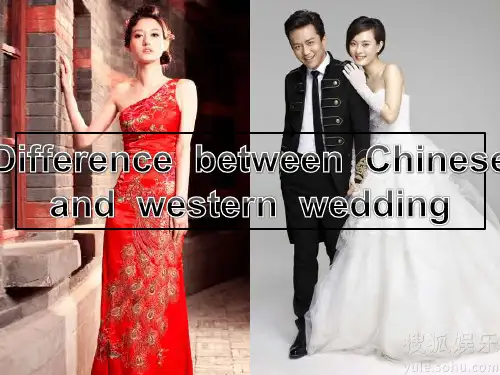
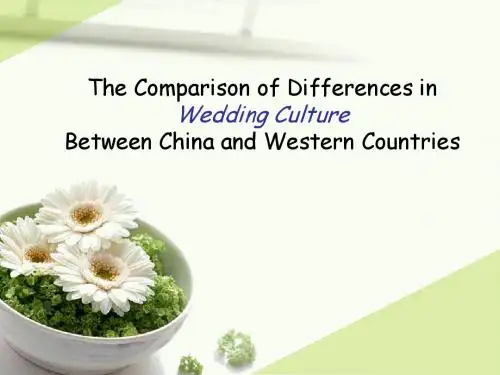
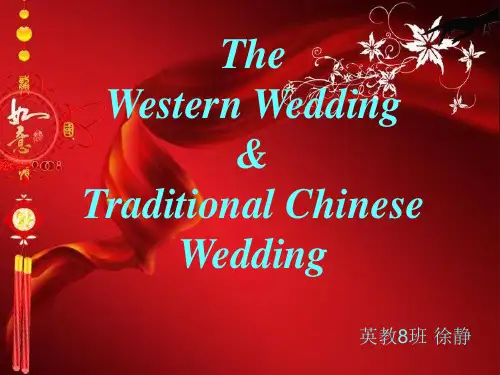
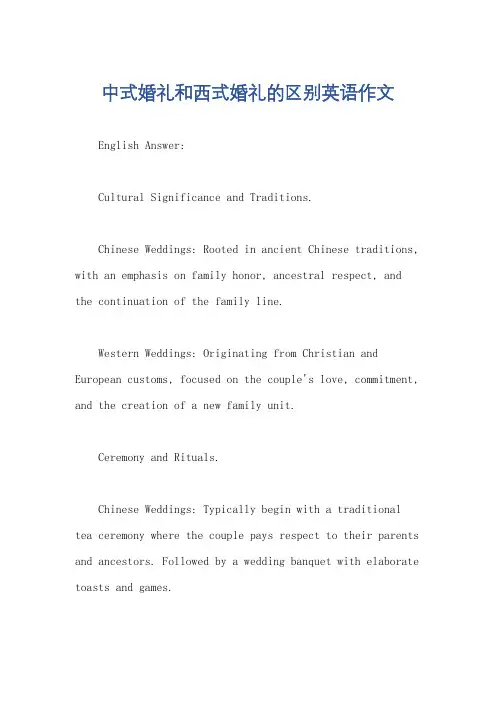
中式婚礼和西式婚礼的区别英语作文English Answer:Cultural Significance and Traditions.Chinese Weddings: Rooted in ancient Chinese traditions, with an emphasis on family honor, ancestral respect, and the continuation of the family line.Western Weddings: Originating from Christian and European customs, focused on the couple's love, commitment, and the creation of a new family unit.Ceremony and Rituals.Chinese Weddings: Typically begin with a traditional tea ceremony where the couple pays respect to their parents and ancestors. Followed by a wedding banquet with elaborate toasts and games.Western Weddings: Usually consist of a formal ceremony with vows, exchange of rings, and a pronouncement of marriage. Often accompanied by a reception with a meal, dancing, and speeches.Wedding Attire.Chinese Weddings: The bride wears a traditional red qipao or cheongsam, symbolizing good luck and prosperity. The groom wears a Tang suit or a Western tuxedo.Western Weddings: The bride typically wears a white gown, representing purity and innocence. The groom wears a tuxedo or a suit and tie.Reception and Entertainment.Chinese Weddings: After the ceremony, the banquet begins with a toasting of the couple and their families. Guests participate in traditional games and entertainment such as the "door game" (where the groom must complete tasks to enter the reception hall).Western Weddings: The reception typically includes a meal, dancing, and entertainment such as a live band or DJ. Speeches from the couple, parents, and guests are common.Roles of Family and Guests.Chinese Weddings: The couple's parents play a significant role in the arrangements and celebrations, reflecting the importance of family and lineage. Guests are expected to follow traditional customs and etiquette.Western Weddings: While family and guests are still important, the couple has more autonomy in planning their wedding. Guests are often encouraged to dress semi-formally and participate in interactive activities.Venue and Decorations.Chinese Weddings: Often held in traditional halls or banqueting halls, adorned with red lanterns, gold dragons, and auspicious symbols.Western Weddings: Typically take place in churches, chapels, or outdoor venues. Decorations often incorporate white, green, and floral arrangements, creating a romantic and ethereal atmosphere.Timeline.Chinese Weddings: Can span multiple days, with pre-wedding ceremonies and festivities leading up to the main banquet.Western Weddings: Usually consist of a single-day event, with the ceremony and reception taking place in close succession.Symbols and Motifs.Chinese Weddings: Red, gold, and double happiness characters represent prosperity, luck, and unity.Western Weddings: White, hearts, and doves symbolizepurity, love, and peace.Chinese Answer:中式婚礼和西式婚礼的区别。
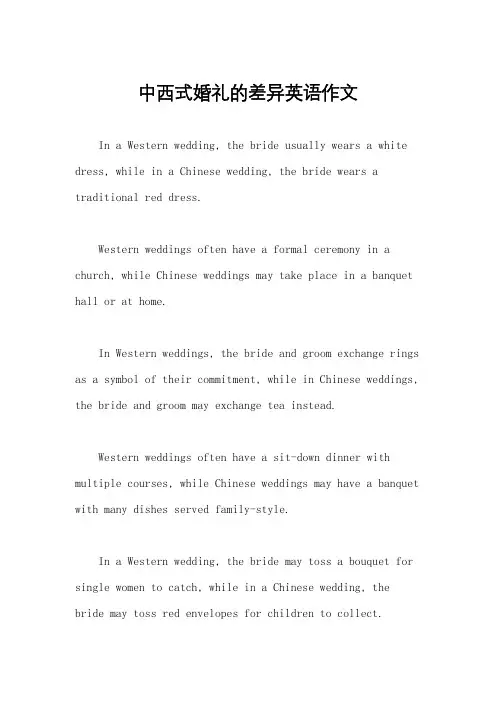
中西式婚礼的差异英语作文In a Western wedding, the bride usually wears a white dress, while in a Chinese wedding, the bride wears a traditional red dress.Western weddings often have a formal ceremony in a church, while Chinese weddings may take place in a banquet hall or at home.In Western weddings, the bride and groom exchange rings as a symbol of their commitment, while in Chinese weddings, the bride and groom may exchange tea instead.Western weddings often have a sit-down dinner with multiple courses, while Chinese weddings may have a banquet with many dishes served family-style.In a Western wedding, the bride may toss a bouquet for single women to catch, while in a Chinese wedding, the bride may toss red envelopes for children to collect.Western weddings may have a first dance between the bride and groom, while Chinese weddings may have a tea ceremony to honor their parents.In Western weddings, the couple may have a honeymoon after the wedding, while in Chinese weddings, the couple may stay with the bride's family for a period of time.In a Western wedding, the bride may have bridesmaids and the groom may have groomsmen, while in a Chinese wedding, the couple may have a large bridal party with many friends and family members.。
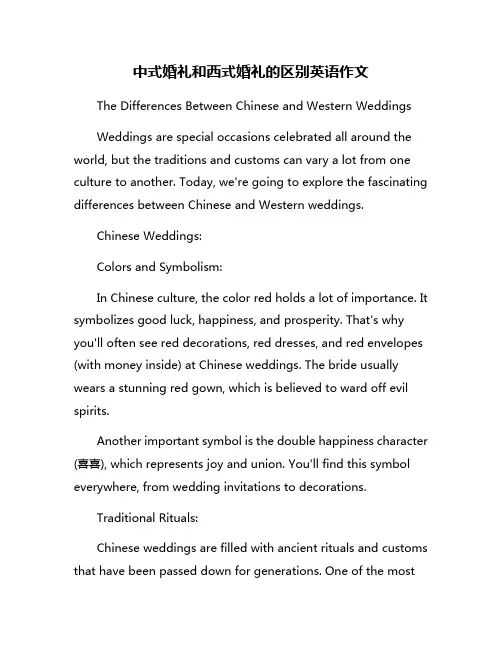
中式婚礼和西式婚礼的区别英语作文The Differences Between Chinese and Western WeddingsWeddings are special occasions celebrated all around the world, but the traditions and customs can vary a lot from one culture to another. Today, we're going to explore the fascinating differences between Chinese and Western weddings.Chinese Weddings:Colors and Symbolism:In Chinese culture, the color red holds a lot of importance. It symbolizes good luck, happiness, and prosperity. That's why you'll often see red decorations, red dresses, and red envelopes (with money inside) at Chinese weddings. The bride usually wears a stunning red gown, which is believed to ward off evil spirits.Another important symbol is the double happiness character (喜喜), which represents joy and union. You'll find this symbol everywhere, from wedding invitations to decorations.Traditional Rituals:Chinese weddings are filled with ancient rituals and customs that have been passed down for generations. One of the mostwell-known traditions is the Tea Ceremony. During this ritual, the bride and groom serve tea to their parents and families as a sign of respect and gratitude.Another interesting tradition is the Hair Combing Ceremony, where the bride's hair is combed and styled by her family members or close friends. This ritual symbolizes the bride's transition from a daughter to a wife.The Groom's Arrival:In Chinese weddings, the groom usually has to go through a series of playful challenges before he can meet his bride. These challenges, known as "Door Games," are organized by the bride's family and friends. The groom and his groomsmen might have to answer riddles, sing songs, or even bribe their way through with money or other treats.Western Weddings:The White Wedding Dress:One of the most iconic symbols of a Western wedding is the white wedding dress. This tradition dates back to the Victorian era, when Queen Victoria wore a white gown for her wedding to Prince Albert in 1840. Since then, white has become thedominant color for bridal gowns, symbolizing purity and innocence.The Bridal Party:In Western weddings, the bride and groom are typically accompanied by a bridal party, which includes bridesmaids and groomsmen. These individuals are usually close friends or family members who support the couple on their special day.The Bouquet and Garter Tosses:Two fun traditions at Western weddings are the bouquet and garter tosses. During the reception, the bride throws her bouquet over her shoulder, and unmarried women try to catch it. It's believed that whoever catches the bouquet will be the next to get married. Similarly, the groom removes the bride's garter and tosses it to the unmarried men, with the same belief that the catcher will be the next to tie the knot.The First Dance:Another beloved tradition in Western weddings is the first dance. After the couple is officially pronounced married, they share their first dance as a married couple, often to a romantic song chosen by them. This moment is usually captured byphotographers and videographers, making it a cherished memory for the newlyweds.Cutting the Cake:No Western wedding would be complete without the iconic cake-cutting ceremony. The bride and groom use a special cake knife to cut the first slice of their wedding cake together, symbolizing their first joint task as a married couple. Guests then enjoy a slice of the delicious cake during the reception.While Chinese and Western weddings have their unique traditions and customs, they both celebrate the union of two people in love. Whether it's the vibrant red gowns of Chinese brides or the pristine white dresses of Western brides, weddings around the world are beautiful expressions of love, joy, and commitment.。

中国和美国婚礼的相同处和不同处英文作文When comparing Chinese and American weddings, there are both similarities and differences in the customs and traditions. Let's take a closer look at the similarities and differences between the two.Similarities:1. Celebration of love and commitment: Both Chinese and American weddings are a celebration of the love and commitment between two individuals. They mark the beginning of a new chapter in the couple's life and are a time for family and friends to come together in support of their union.2. Wedding attire: In both cultures, the bride typically wears a white wedding dress, symbolizing purity and innocence. The groom usually wears a suit, although the style and color may vary between the two cultures.3. Exchange of vows and rings: Both Chinese and American weddings involve the exchange of vows and rings between the bride and groom. This symbolizes their commitment to eachother and their promise to love and cherish one another for the rest of their lives.4. Wedding banquet: In both cultures, it is customary to have a wedding banquet or reception after the ceremony. This is a time for guests to enjoy a meal together and celebrate the newlyweds.Differences:1. Traditional customs and rituals: Chinese weddings are often steeped in traditional customs and rituals that have been passed down through generations. These may include the tea ceremony, where the couple serves tea to their parents as a sign of respect and gratitude. American weddings, on the other hand, may incorporate customs such as the exchange of vows and the throwing of the bouquet.2. Guest list and size: Chinese weddings tend to have a larger guest list compared to American weddings. It is not uncommon for Chinese weddings to have hundreds of guests in attendance, while American weddings are often more intimate affairs with a smaller number of guests.3. Wedding venue: In China, it is common for weddings to take place in banquet halls or restaurants, where the focus is on the wedding banquet. In the United States, weddings may take place in a variety of venues, including churches, gardens, beaches, or even destination weddings in exotic locations.4. Wedding gifts: The tradition of giving wedding gifts differs between the two cultures. In China, it is customary for guests to give monetary gifts in red envelopes, symbolizing good luck and prosperity. In the United States, guests often give gifts from a wedding registry or choose to give cash or checks.中文:当我们比较中美两国的婚礼时,可以发现在习俗和传统上既有相似之处,也有不同之处。
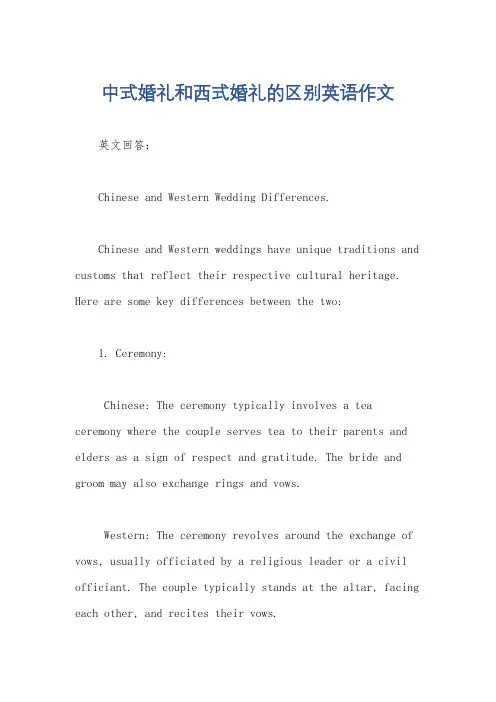
中式婚礼和西式婚礼的区别英语作文英文回答:Chinese and Western Wedding Differences.Chinese and Western weddings have unique traditions and customs that reflect their respective cultural heritage. Here are some key differences between the two:1. Ceremony:Chinese: The ceremony typically involves a tea ceremony where the couple serves tea to their parents and elders as a sign of respect and gratitude. The bride and groom may also exchange rings and vows.Western: The ceremony revolves around the exchange of vows, usually officiated by a religious leader or a civil officiant. The couple typically stands at the altar, facing each other, and recites their vows.2. Attire:Chinese: The bride traditionally wears a red dress, symbolizing joy and prosperity. The groom wears a long gown called a "changshan."Western: The bride wears a white dress, often associated with purity and innocence. The groom typically wears a suit or tuxedo.3. Reception:Chinese: The reception is usually held in a restaurant or banquet hall. It features a multi-course feast, toasts to the couple, and traditional entertainment such as lion dances.Western: The reception typically takes place at a reception venue and includes a buffet or sit-down dinner. There is often music, dancing, and socializing.4. Gifts:Chinese: Guests traditionally give gifts of money wrapped in red envelopes. The amount of money given varies depending on the relationship with the couple.Western: Guests usually bring physical gifts or gift cards registered by the couple.5. Guests:Chinese: Weddings tend to have a large number of guests, including extended family, friends, and colleagues.Western: Weddings typically have a smaller guest list, focusing on close family and friends.6. Honeymoon:Chinese: Honeymoon destinations are often chosen based on cultural significance, such as the Great Wall of China or the Terracotta Army.Western: Honeymoon destinations are typically chosen for relaxation and adventure, such as tropical islands or European cities.中文回答:中式婚礼与西式婚礼的区别。
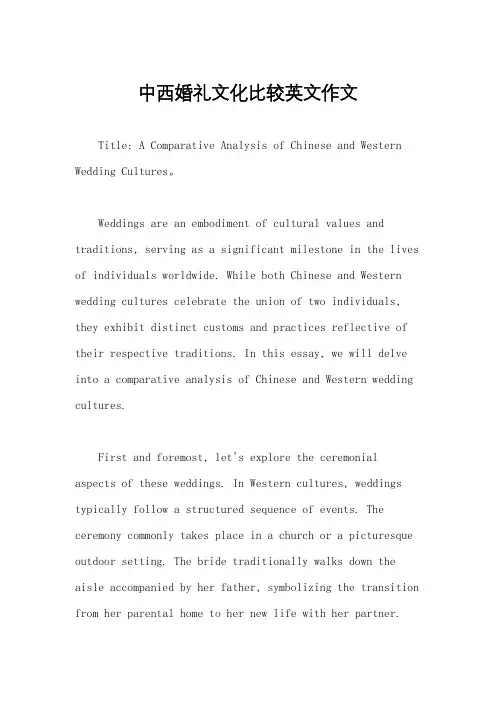
中西婚礼文化比较英文作文Title: A Comparative Analysis of Chinese and Western Wedding Cultures。
Weddings are an embodiment of cultural values and traditions, serving as a significant milestone in the lives of individuals worldwide. While both Chinese and Western wedding cultures celebrate the union of two individuals, they exhibit distinct customs and practices reflective of their respective traditions. In this essay, we will delve into a comparative analysis of Chinese and Western wedding cultures.First and foremost, let's explore the ceremonial aspects of these weddings. In Western cultures, weddings typically follow a structured sequence of events. The ceremony commonly takes place in a church or a picturesque outdoor setting. The bride traditionally walks down the aisle accompanied by her father, symbolizing the transition from her parental home to her new life with her partner.Vows are exchanged, often personalized by the couple, followed by the exchange of rings as a symbol of eternal love and commitment.Contrastingly, Chinese weddings are deeply rooted in tradition and symbolism. One of the most notable aspects is the use of vibrant red color, symbolizing joy, luck, and prosperity in Chinese culture. The wedding ceremony often incorporates rituals such as the Tea Ceremony, where the newlyweds serve tea to their parents as a gesture of respect and gratitude. Additionally, the exchange of hongbao (red envelopes containing money) is customary, symbolizing good luck and blessings for the newlyweds' future.Another significant difference lies in the attire worn by the bride and groom. In Western weddings, the bride traditionally wears a white gown, symbolizing purity and innocence, while the groom wears a suit or tuxedo. However, modern trends have seen a deviation from this tradition, with brides opting for various colors and styles. In contrast, Chinese brides often wear elaborate red qipaos orcheongsams, adorned with intricate embroidery and gold accents. The groom typically wears a black suit with a red tie or a traditional Tang suit, symbolizing auspiciousness and happiness.Furthermore, the role of family and guests differs between Chinese and Western weddings. In Western weddings, guests play a significant role in celebrating the union of the couple, often participating in rituals such as throwing the bouquet or giving toasts. Family members may also have specific roles, such as serving as bridesmaids or groomsmen. In contrast, Chinese weddings emphasize familial ties and respect for elders. Family members are actively involved in the wedding planning process and play a crucial role in the ceremonial rituals, such as the Tea Ceremony mentioned earlier.In terms of post-wedding customs, both Chinese and Western cultures have their unique traditions. In Western culture, the newlyweds often embark on a honeymoon immediately after the wedding ceremony, symbolizing the beginning of their new life together. Chinese weddings, onthe other hand, may include additional rituals such as the "fetching of the bride," where the groom and his groomsmen must pass various challenges set by the bridesmaids before he can claim his bride.In conclusion, while Chinese and Western wedding cultures share the common goal of celebrating love and commitment, they differ significantly in terms of rituals, attire, and societal customs. Each culture brings its unique traditions and symbolism to the ceremony, reflecting the rich tapestry of human diversity and expression. Ultimately, whether it's a Western white wedding or a Chinese red wedding, the essence of love and unity transcends cultural boundaries, making weddings a universally cherished celebration of life and partnership.。
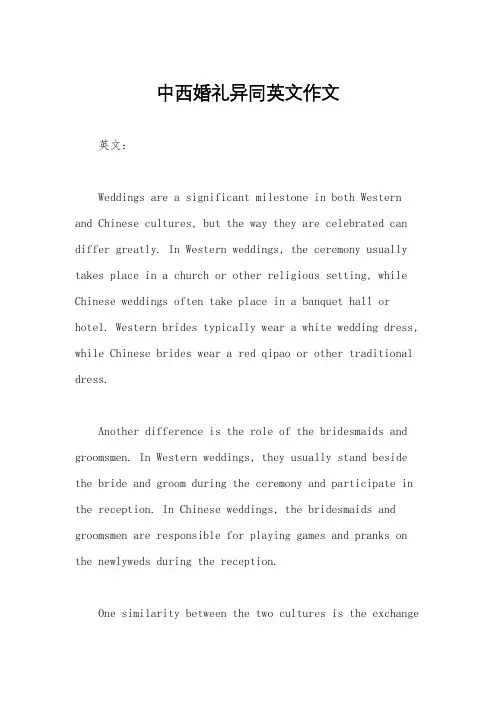
中西婚礼异同英文作文英文:Weddings are a significant milestone in both Western and Chinese cultures, but the way they are celebrated can differ greatly. In Western weddings, the ceremony usually takes place in a church or other religious setting, while Chinese weddings often take place in a banquet hall or hotel. Western brides typically wear a white wedding dress, while Chinese brides wear a red qipao or other traditional dress.Another difference is the role of the bridesmaids and groomsmen. In Western weddings, they usually stand beside the bride and groom during the ceremony and participate in the reception. In Chinese weddings, the bridesmaids and groomsmen are responsible for playing games and pranks on the newlyweds during the reception.One similarity between the two cultures is the exchangeof rings. Both Western and Chinese weddings involve the exchange of wedding rings as a symbol of the couple's commitment to each other. Another similarity is the importance of the wedding banquet. In both cultures, the wedding banquet is a time for family and friends to come together and celebrate the newlyweds.中文:婚礼是西方和中国文化中的重要里程碑,但庆祝方式可能有很大的不同。
中国婚礼和西方婚礼的区别英语作文全文共10篇示例,供读者参考篇1Chinese wedding and Western wedding are different in many ways.First of all, the ceremony in Chinese wedding usually takes place in a banquet hall or a special venue chosen by the couple's families. The ceremony usually includes traditional rituals such as the tea ceremony and the . However, in a Western wedding, the ceremony takes place in a church or a dedicated wedding venue, with the bride walking down the aisle and the couple exchanging vows and rings in front of a priest or an officiant.Secondly, the attire in Chinese wedding is often a traditional red qipao for the bride and a black suit for the groom. The guests are also encouraged to wear red or other festive colors. In contrast, in a Western wedding, the bride usually wears a white wedding dress and the groom wears a suit or tuxedo. The guests are expected to dress formally in accordance with the wedding theme.Another difference is the reception. In Chinese wedding, the reception is often a grand banquet with multiple courses of delicious Chinese food. There may also be performances such as lion dances or traditional music. On the other hand, in a Western wedding, the reception usually includes a sit-down dinner, a cake cutting ceremony, and dancing. The couple may also have a first dance and toss the bouquet and garter to single guests.Overall, while both Chinese wedding and Western wedding are special and memorable occasions, they have their own unique customs and traditions that make them distinct from each other. It's interesting to see how couples from different cultures celebrate their love and commitment in different ways.篇2Oh wow, have you ever thought about the differences between Chinese weddings and Western weddings? Let me tell you all about it!First of all, in a Chinese wedding, the bride and groom would have a traditional ceremony called "Guo Da Li" to exchange gifts. The groom's family would give gifts to the bride's family as a sign of respect and thanks. This is a way to show that both families are coming together in a harmonious union. In Westernweddings, there is usually a rehearsal dinner the night before the wedding where the families and close friends gather to celebrate the upcoming nuptials.Another big difference is the attire of the bride and groom. In Chinese weddings, the bride would wear a red dress, which symbolizes good luck and happiness, while the groom would wear a traditional black suit. In Western weddings, the bride usually wears a white dress, symbolizing purity and innocence, and the groom wears a tuxedo.During the ceremony, Chinese weddings usually involve a lot of rituals and customs, such as the tea ceremony where the couple serves tea to their elders as a sign of respect. In Western weddings, there is the tradition of exchanging vows and rings as a symbol of their commitment to each other.After the ceremony, the Chinese wedding banquet is a big feast with lots of delicious food and toasts to the newlyweds. In Western weddings, there is usually a reception with dancing, speeches, and cutting the cake.So, as you can see, there are quite a few differences between Chinese weddings and Western weddings. But no matter where you are in the world, weddings are a special celebration of love and unity between two people.篇3Chinese weddings and Western weddings are different in many ways! Let me tell you all about it!First of all, Chinese weddings usually have a lot of traditions and customs. For example, in a Chinese wedding, the bride and groom have to do a lot of bowing to show respect to their parents and elders. Western weddings, on the other hand, are more about the couple exchanging vows and rings to show their love for each other.Another big difference is the food at the wedding. Chinese weddings usually have a big feast with lots of traditional dishes like roast duck, fish, and dumplings. Western weddings often have a fancy dinner with options like steak, chicken, and salads.Also, the attire at Chinese weddings is very different. The bride in a Chinese wedding usually wears a red dress called a qipao, while the groom wears a suit. In a Western wedding, the bride usually wears a white dress and the groom wears a tuxedo.One more difference is the decorations at the wedding. Chinese weddings often have lots of red decorations because red is a lucky color in Chinese culture. Western weddings may have more neutral colors like white, silver, and gold.In conclusion, Chinese weddings and Western weddings are both beautiful in their own ways, but they are definitely different when it comes to traditions, food, attire, and decorations. It's so cool to see all the different ways people celebrate love around the world!篇4Hello everyone! Today I'm going to talk about the differences between Chinese weddings and Western weddings.First of all, in Chinese weddings, the color red is considered to be very lucky, so most of the decorations, including the bride's dress, are in red. People believe that the color red can bring good fortune and happiness to the newlyweds. On the other hand, in Western weddings, the color white is the most common choice for the bride's dress. White symbolizes purity and innocence.Secondly, in Chinese weddings, the bride and groom usually serve tea to their parents and older relatives as a sign of respect. This is a traditional ceremony called "tea ceremony". While in Western weddings, there is a tradition called the "exchange of vows", where the bride and groom express their love and commitment to each other in front of their family and friends.Moreover, the wedding ceremonies in China are often very grand and involve many rituals and customs that have been passed down for generations. In contrast, Western weddings are usually simpler and more focused on the love and commitment between the couple.In conclusion, both Chinese and Western weddings have their own unique customs and traditions. Whether it's the color of the decorations, the rituals involved, or the overall atmosphere, each type of wedding has its own charm and beauty. It's important to respect and appreciate the differences between the two and celebrate the love and happiness of the newlyweds. Thank you for listening!篇5Hey everyone, today I am going to talk about the differences between Chinese weddings and Western weddings. Let's get started!First of all, let's talk about the location. In China, weddings are usually held in a restaurant or banquet hall, while in Western countries, weddings are often held in churches or outdoor venues like gardens or beaches.Secondly, let's talk about the dress code. In China, brides usually wear a traditional red dress called a qipao, while in Western countries, brides wear white dresses. Also, in Western weddings, the groom usually wears a suit or tuxedo.Next, let's talk about the ceremony. In Chinese weddings, there are many traditional customs like the tea ceremony and the exchange of gifts, while in Western weddings, there is usually a ceremony officiated by a priest or minister.Another difference is the food. In Chinese weddings, there are usually many courses of food served during the banquet, while in Western weddings, there is usually a sit-down dinner with a few courses.Lastly, let's talk about the traditions. In Chinese weddings, there are many superstitions and customs that must be followed, while in Western weddings, there are also traditions like throwing the bouquet and cutting the cake.In conclusion, Chinese weddings and Western weddings have many differences in terms of location, dress code, ceremony, food, and traditions. It's interesting to see how different cultures celebrate this special occasion. Thank you for listening!篇6Hey guys, today I want to talk about the differences between Chinese weddings and Western weddings. There are actually a lot of differences, so let's get started!First of all, in a Chinese wedding, the traditions are very important. We have lots of rituals and ceremonies that have been passed down for generations. For example, we have the Tea Ceremony where the bride and groom serve tea to their parents to show respect and gratitude. We also have the Lion Dance to ward off evil spirits and bring good luck to the newlyweds.On the other hand, in Western weddings, there are also traditions, but they are a bit different. For example, the bride typically wears a white dress and walks down the aisle with her father. There is also the exchange of rings and vows, which symbolize the couple's commitment to each other.Another big difference is the guest list. In Chinese weddings, it's common to invite a lot of people, including distant relatives and friends of friends. Western weddings tend to be more intimate, with only close family and friends in attendance.Food is also a big difference between Chinese and Western weddings. In Chinese weddings, there is usually a big banquet with lots of dishes to symbolize abundance and prosperity. In Western weddings, there is often a sit-down dinner with a few courses.Overall, both Chinese and Western weddings are special in their own ways. It's really cool to see how different cultures celebrate love and marriage. I hope you guys learned something new today! Thanks for listening!篇7Hello everyone, today I'm going to talk about the differences between Chinese weddings and Western weddings. So, are you ready? Let's get started!First of all, let's talk about the ceremony itself. In a Chinese wedding, there are many different customs and traditions that have been passed down for generations. For example, the bride and groom will often bow to their parents as a sign of respect and gratitude. There are also many symbolic gestures, like the exchange of tea or the firecrackers to ward off evil spirits.On the other hand, Western weddings tend to be more simple and straightforward. The ceremony usually takes place ina church, with the bride wearing a white dress and the groom wearing a suit. Instead of bowing, the couple will exchange vows and rings to show their commitment to each other.Next, let's talk about the food. In a Chinese wedding, the banquet is a big deal! There are usually many courses of delicious food, and the guests are expected to eat a lot to show their appreciation. There might also be a lot of toasts and speeches throughout the meal.In contrast, Western weddings often have a more relaxed approach to food. There might be a sit-down dinner or a buffet, but the focus is typically on the wedding cake. The cutting of the cake is a tradition that symbolizes the couple's first meal together as husband and wife.Lastly, let's talk about the attire. In a Chinese wedding, the bride will often wear a traditional red qipao or cheongsam, while the groom will wear a black or blue suit. The bridesmaids and groomsmen will also dress in matching outfits.In a Western wedding, the bride usually wears a white wedding dress, while the groom wears a tuxedo. The bridesmaids and groomsmen will also coordinate their outfits, but they tend to have more freedom in choosing their attire.In conclusion, Chinese weddings and Western weddings are both beautiful and meaningful in their own ways. Whether you're bowing to your parents or exchanging vows in a church, the most important thing is to celebrate the love between the bride and groom. Let's embrace the diversity of wedding traditions and appreciate the beauty of each culture's customs. Thank you for listening, and I hope you enjoyed learning about the differences between Chinese and Western weddings!篇8Oh my God, have you ever seen a Chinese wedding and a Western wedding before? They are totally different and super cool! Let me tell you all about it!First of all, in a Chinese wedding, the bride wears a red dress because red is a lucky color in China. But in a Western wedding, the bride usually wears a white dress because white symbolizes purity and innocence. And the groom wears a black suit in both Chinese and Western weddings.Secondly, in a Chinese wedding, there are a lot of traditional customs like the tea ceremony, where the newlyweds serve tea to their parents and elders as a way to show respect and gratitude. But in a Western wedding, there is the exchange ofvows and rings, where the bride and groom declare their love for each other in front of everyone.Next, the food at a Chinese wedding is super yummy! There are so many dishes like dumplings, noodles, and roast duck. But at a Western wedding, the food is more like a fancy dinner with steak, salad, and cake for dessert.And guess what? Chinese weddings have lots of games and challenges for the newlyweds to complete, like finding the bride’s shoe or breaking peanuts for good luck. But in Western weddings, there are dancing and speeches that make everyone cry and laugh.In conclusion, Chinese weddings and Western weddings are both so exciting and special in their own ways. Whether it’s the colorful traditions of a Chinese wedding or the romantic vows of a Western wedding, both celebrations are full of love and happin ess. Wow, I can’t wait to go to a wedding now!篇9China wedding and western wedding are very different. I will tell you some differences in a very simple way.Firstly, in China, we have a lot of traditional customs in a wedding. We need to prepare a lot of red stuff, like red dress, red shoes, red flowers and so on. Red is a color of happiness and good luck for us. But in western wedding, they like white color more. The bride will wear a white dress, the groom will wear a suit. The church will be decorated in white with lots of white flowers.Secondly, in China, we have a lot of ceremonies during a wedding, such as tea ceremony, hair combing ceremony, and so on. These ceremonies are to show respect to our parents and elders. But in western wedding, they have fewer ceremonies, usually just exchange rings and vows.Lastly, in China, we like to have a big feast after the wedding ceremony. We will invite all our relatives and friends to celebrate with us. But in western wedding, they usually have a smaller reception with close family and friends.In conclusion, China wedding and western wedding are different in many ways. But no matter how different they are, the most important thing is to celebrate love and the beginning of a new life together. So, no matter which type of wedding, as long as the couple is happy, that's all that matters!篇10Chinese weddings and Western weddings are different in many ways. Let me tell you all about it!First of all, in Chinese weddings, the couple has to do many traditional ceremonies, like the tea ceremony where they serve tea to their elders. But in Western weddings, they usually just have a ceremony at the church or a beautiful venue.In Chinese weddings, we wear traditional red clothes, and the bride usually wears a red qipao. But in Western weddings, the bride wears a white wedding dress, and the groom wears a black tuxedo.Another difference is the food! In Chinese weddings, we have a big feast with lots of delicious dishes like dumplings and noodles. But in Western weddings, they usually have a sit-down dinner with fancy dishes like steak and salad.And don't forget about the decorations! In Chinese weddings, we have lots of red decorations because red is a lucky color. But in Western weddings, they have all kinds of decorations like flowers and candles.Lastly, the way we celebrate is different too. In Chinese weddings, we have lots of games and activities to celebrate. But in Western weddings, they usually have a first dance and a cake cutting ceremony.So you see, Chinese weddings and Western weddings are very different, but they are both special in their own way. I hope you learned something new about weddings!。
中式婚礼和西式婚礼的区别英语作文English: Chinese weddings and Western weddings have several key differences that stem from their respective cultural traditions. In a Chinese wedding, the emphasis is placed on family and respect for tradition. The ceremony typically involves rituals that have been passed down through generations, such as the tea ceremony where the couple serves tea to their elders to show respect and gratitude. Red is a prominent color in Chinese weddings, symbolizing joy and prosperity. In contrast, Western weddings often focus on the individualism of the couple, with personal touches and unique elements incorporated into the ceremony. Western weddings commonly involve exchanging vows, exchanging rings, and a first dance as newlyweds. The attire also differs, with Chinese brides typically wearing a traditional red qipao or cheongsam, while Western brides opt for white wedding gowns. Overall, while both types of weddings celebrate love and unity, the cultural traditions and customs inherent in each ceremony set them apart in terms of style and symbolism.中文翻译: 中国婚礼和西方婚礼有几个根源于各自文化传统的关键差异。
中式婚礼和西式婚礼的区别英语作文(中英文版)**Differences between Chinese and Western Weddings**In the grandeur of matrimony, cultural nuances play a significant role in shaping the婚礼仪式.Chinese and Western weddings, in particular, couldn’t be more distinct from each other in terms of traditions,仪式, and attire.Let’s delve into the key differences between these two marital celebrations.Firstly, in Chinese weddings, the color red is predominantly used as it symbolizes good luck, joy, and prosperity.The bride typically wears a stunning red qipao or a modern wedding dress with red accents.In contrast, Western weddings often feature a white or ivory gown for the bride, symbolizing purity and innocence.Secondly, the仪式process varies greatly.Chinese weddings often start with the groom and his entourage going to the bride’s home to fetch her, a tradition known as " fetching the bride." This is followed by various games and challenges set by the bridesmaids to test the groom’s love and sincerity.In Western weddings, the ceremony usually takes place in a church or outdoor setting, where the bride walks down the aisle with her father, and the couple exchanges vows and rings.Another distinct difference lies in the wedding banquet.Chinese weddings often involve a elaborate multi-course meal, with dishes suchas shark’s fin soup, abalone, and red bean soup, symbolizing wealth and happiness.Western weddings typically have a wedding cake, with the tradition of cutting the cake together symbolizing the couple’s shared life.Furthermore, in Chinese weddings, the exchange of wedding gifts is an essential part of the celebration.These gifts often include money, jewelry, or valuable items, which are given by both families to express their blessings and support.In contrast, Western weddings usually focus on the registry, where guests can choose gifts from a list provided by the couple.Lastly, the guest list can differ significantly.Chinese weddings often involve a larger guest count, including friends, family, colleagues, and even business associates.In Western weddings, the guest list tends to be smaller and more intimate, focusing on close friends and family.In conclusion, the differences between Chinese and Western weddings are evident in their cultural expressions,仪式, attire, and guest dynamics.While both are beautiful celebrations of love and unity, they offer a fascinating glimpse into the diverse tapestry of wedding traditions across the globe.**中式婚礼与西式婚礼的差异**在婚姻的盛况中,文化差异在塑造婚礼仪式上起着重要的作用。
The Difference between Chinese and Western WeddingAlong with China's economic globalization and the Chinese traditional culture influence to the world, the Chinese and western communication is increasingly closing. Recognition and understanding of the world culture and custom become more and more necessary .The culture in wedding between Chinese and western has lots of differences.1 The different colors in weddingFor instance, red is the color appeared most in Chinese wedding, as it represent good luck and indicates that couples will live happily ever after. However, black and white are most commonly used in Western wedding, they represent the sublimity of marriage. There are also differences in what people wear in their wedding. In China, brides wear Chinese traditional cheongsam; while in the Western brides usually wear white knops dresses.2 Spree in the Bridal ChamberThough many traditional activities can no longer be seen at a Chinese wedding, the spree in the bridal chamber is still common both in the country and in town. The spree happens after the feast when the bride and groom go back into their chamber. Relatives and friends and neighbors, any one at the wedding in fact, can come in to play all kinds of tricks on the new couple, especially the bride. They make a lot of noise so that there is an extremely lively atmosphere in the room, which is believed to be an inseparable part of a jolly wedding.3 The process from being engaged to marry In the WestIn the West, in the love men and women want to marry, must first propose (propose) by the groom's family to the bride's side, when proposing the groom's family should bestow the betrothal ring to the bride's side. Therefore, when the people mentioned when “He gave her a ring”, its significance usually is He proposed to her, she accepted, and they are now engaged. Engagement's men and women should consider immediately theirs marriage plan the respective parents, usually by bride's parents announced that becomes engaged with the wedding ceremony. According to the tradition, bears the majority of wedding ceremony expense by bride's family, but bridegroom family Fang Zen is responsible to have a dress rehearsal the feast and other matters concerned. The wedding ceremonystarts previous 1-2 days should officially to have a dress rehearsal, does the goal is causes to participate in wedding ceremony's each people to be familiar with them to want the routine procedure at the wedding ceremony.4 The wedding ceremony in the Western country is a very important situation,In the hold wedding ceremony first several weeks, the relatives and friends will receive the invitation letter. The wedding ceremony is moreover is held in the church in the daytime, if you attain the invitation, then when attends the wedding ceremony the clothing should be official. The female guest puts on the cocktail party formal clothes either the long shirt adds the holiday coat or the woolen sweater; the male guest wants to put on the formal clothes. It is noteworthy that woman puts on the pants is inappropriate, regardless of the pants are any color.5 the wedding flowerAt the westerner wedding ceremony flowers are funded at everywhere, from the church to the hotel, slightly to church in each chair, there is no place does not have the flower's existence. They like the use pink color department the flower, powdery white, the powder is blue, flesh color, the powder is green, and powder purple, light creamy yellow…Moreover they like using the fresh flowers, will not use the artificial flower. Generally marries every time to the new person, fresh flower's amount of use is quite big. Finds at everywhere is the flower, because of each splendid attire attendance woman, no matter its age, can put on a wad flower in the chignon place to show to new people's respect.6 Giving a presentGives a present is the custom which many nationalities altogether have, especially in china then time relatives and friends’ marriage what delivers ]ell We provide some principles for everybody reference: First is posse. Belly the goods which likes for the accepting gifts person, next do not be too expensive, has is again must have the usability.7 The custom of veil and kissWestern female when marriage also has wears veil's custom, at first, the bride wears the veil is young and the chastity symbol, but believes in Catholicism's bride to wear the veil to represent chastely. Therefore, many brides rush to the church holds when the wedding ceremony chooses wear the double-decked veil. After bride's father gives the daughter the bridegroom, by the bridegroom personally opened the veil. Finally, according to the custom, the wedding ceremony finished by new person's kiss announcement. This kisses the rich profound meaning: Through kissing,a person's breath and the partial souls keep another person in vivo, love cause them to combine. However in china people like to choose the red veil and kiss the lover at no others’ place.8 The main character of Chinese weddingChinese wedding ceremonies end with fireworksChinese weddings gather people for a banquet after the ceremony, usually on a restaurant. Western couples invite people to their home.The Chinese bride and groom are usually chosen by their parents; if they disobey their parents' wish, they can be social outcasts, lose their jobs and so on. Marriage in China is thus more of a social contract between families than a binding of love. This is one reason to why out of wedlock relations are so common in China. And it is also a reason to why Chinese girls look for foreigner. Note that children born out of wedlock have no rights in China; no right to go to school, no right to medical care and so on; this is what the 5000 year old culture so proudly call human interestIn shortCultural traditions range from dress to participation. In some cases a groom takes the lead and in others the bride takes the leading role. Wedding ceremonies differ greatly - not just between China and the Western countries - but they differ widely even among the people themselves in any country you choose to look at. Through the study of differences between Chinese and western at the wedding of the cultural I have opened horizon and Learned lots of knowledge.。